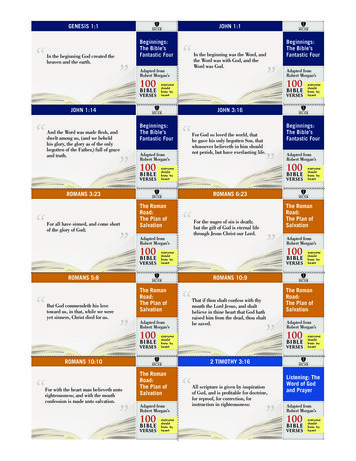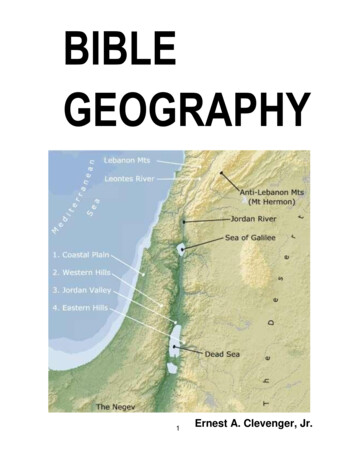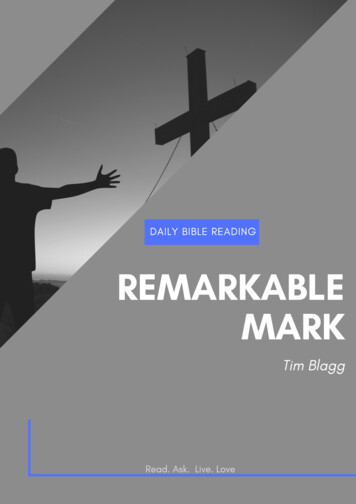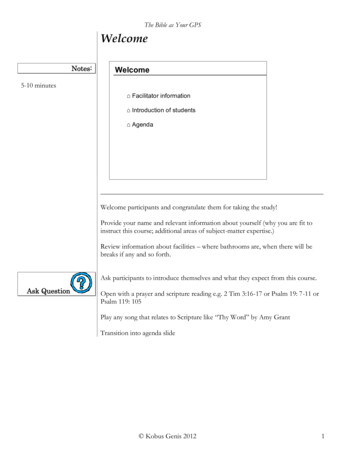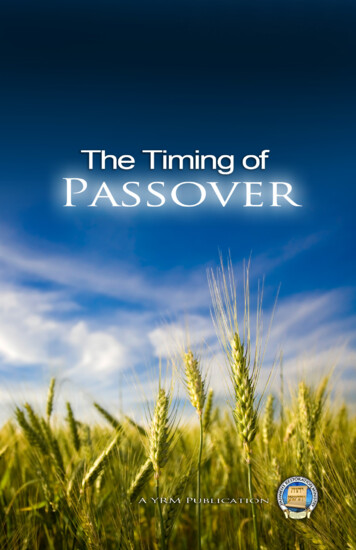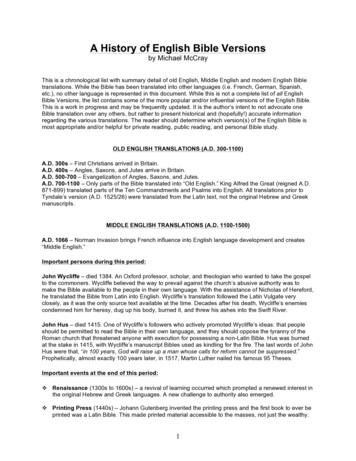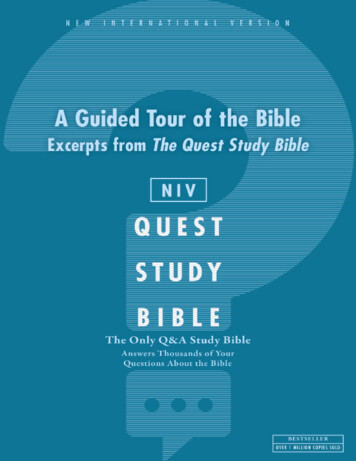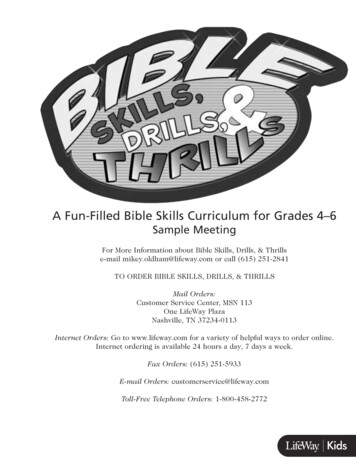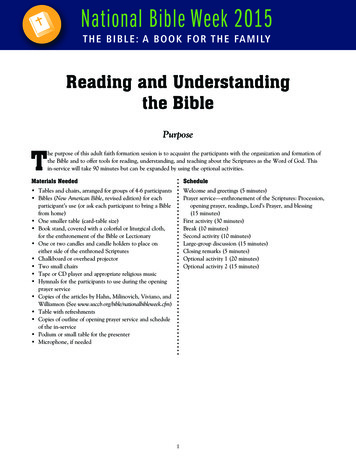
Transcription
Reading and Understandingthe BiblePurposeThe purpose of this adult faith formation session is to acquaint the participants with the organization and formation ofthe Bible and to offer tools for reading, understanding, and teaching about the Scriptures as the Word of God. Thisin-service will take 90 minutes but can be expanded by using the optional activities.Materials NeededSchedule Tables and chairs, arranged for groups of 4-6 participants Bibles (New American Bible, revised edition) for eachparticipant’s use (or ask each participant to bring a Biblefrom home) One smaller table (card-table size) Book stand, covered with a colorful or liturgical cloth,for the enthronement of the Bible or Lectionary One or two candles and candle holders to place oneither side of the enthroned Scriptures Chalkboard or overhead projector Two small chairs Tape or CD player and appropriate religious music Hymnals for the participants to use during the openingprayer service Copies of the articles by Hahn, Milinovich, Viviano, andWilliamson (See www.usccb.org/bible/nationalbibleweek.cfm) Table with refreshments Copies of outline of opening prayer service and scheduleof the in-service Podium or small table for the presenter Microphone, if neededWelcome and greetings (5 minutes)Prayer service—enthronement of the Scriptures: Procession,opening prayer, readings, Lord’s Prayer, and blessing(15 minutes)First activity (30 minutes)Break (10 minutes)Second activity (10 minutes)Large-group discussion (15 minutes)Closing remarks (5 minutes)Optional activity 1 (20 minutes)Optional activity 2 (15 minutes)1
PreparationWhen preparing this in-service, please read the articles by Hahn, Milinovich, Viviano, and Williamson that are found on theNational Bible Week webpage. This in-service is based upon these articles.If finances allow, please print out copies of these articles to distribute to participants at the end of the meeting.For the Prayer Service Select a prayer leader, five readers, and a cantor, if possible.Ask the leaders, readers, and cantor to prepare their readings and songs.Ask the cantor to pick songs from the parish hymnal that are familiar to the participants (see suggestions).Drape the cloth over the bookstand on the small table where you will enthrone the Scriptures. The table should be setapart from the podium but be prominently visible to all the participants. Construct a handout that outlines the prayer service, and make copies for participants.Welcome (5 minutes)Have copies of the schedule and prayer service available at the door as participants sign in. Select people to lead the prayer,read from Scripture, and lead the song (see preparation for the prayer service, above). Have religious music playing softly aspeople gather.When it is time to start, welcome everyone. Explain the purpose of the workshop, and review the schedule.Prayer Service—Enthronement of the Scriptures (15 minutes)The opening prayer begins with a procession of two candlebearers, the prayer leader, and two lectors, one of whom carriesthe Bible or Lectionary prominently. If a priest or deacon is available, have him serve as prayer leader and read the Gospel.Invite participants to join in singing the opening song as the procession moves from the back of the room to the covered table.When the procession has reached the enthronement table, those in the procession should face the other participants untilthe present verse and refrain of the opening song are finished. The lector reverently places the Scripture on the table stand.All bow before the Scriptures. The readers move to chairs that have been placed off to the side. The candlebearers place thecandles on either side of the table and return to their seats among the participants.The leader begins the opening prayer from the table or podium, using a microphone if necessary. Then the leader steps to achair off to the side and invites participants to sit.The lector approaches the table, bows in front of the enthroned Scriptures, picks up the Scriptures, and proclaims thefirst reading. If a microphone is needed, the lector may proclaim from the podium. When finished, the reader places theScriptures back on the enthronement table.The cantor leads a responsorial psalm; if there is no cantor, the people may sing or recite the psalm. Invite participants tosing the refrain from a parish hymnal or printed sheet.Invite participants to stand for the second reading.The lector (or priest or deacon) again walks to the table, reverently picks up the Scriptures, and reads the Gospel aloud.When finished, the lector (or priest or deacon) places the Scriptures back on the enthronement table. The participants sit.2
Three additional readers now approach the podium. Eachone slowly reads an additional reflection from the SecondVatican Council’s Dogmatic Constitution on Divine Revelation(see “Reflective Readings,” below). Book of Blessings, no. 500: Prayer of Blessing (if a priestis leading the prayer service, he prays the blessing withhands outstretched; a lay leader simply says the blessingas a prayer)A period of silence follows.Music SuggestionsOpening Song “Your Words Are Spirit and Life”(Bernadette Farrell, OCP) “Praise to You, O Christ, Our Savior”(Bernadette Farrell, OCP) “Laudate Dominum”(Jacques Berthier, GIA Publications) “How Shall We Name God?”(Thomas Troeger, GIA Publications)After a few moments, the leader asks the participants to riseand invites them to recite together theLord’s Prayer.A final Prayer of Blessing is read by the leader.The leader and readers process from the front of the roomin the same order as they entered at the beginning, leavingthe Scriptures enthroned on the table.Responsorial PsalmIf it is safe to do so, leave the candles lit. “O Word of God”(Ricky Manalo, CSP, OCP) “Lord, You Have the Words”(David Haas, GIA Publications)Reading Suggestions First Reading: Deuteronomy 6:6-9 Gospel: John 1:1-5, 14:24-25Closing SongReflective Readings “Take the Word of God with You”(Christopher Walker, OCP) “How Can I Keep from Singing?”(Robert Lowery, GIA Publications) “Thuma Mina”(South African, Utryck, Walton Music Corp.)Second Vatican Council, Dogmatic Constitution on DivineRevelation, nos. 2, 4, 7 (found online at www.vatican.va/archive/hist councils/ii vatican council/documents/vat-ii const19651118 dei-verbum en.html).Prayer Suggestions Book of Blessings, no. 459 (from the “Blessing ofMissionaries Sent to Proclaim the Gospel”)First Activity (30 minutes)1. Make a brief presentation (12 minutes) that summarizes the main points from the article “Basics of BiblicalLiteracy” (Milinovich). Be sure to leave time for questions. Put the main points on an overhead or handout,if possible. The participants should follow the division ofbooks from the table of contents in their Bibles. Be sureto explain the following points: The meaning of the word “canon” The Old Testament division of books, and what eachgroup is generally about (note that some Bibles haveonly three divisions) How the Old Testament was formed, and the approximate dates of books When the Old Testament canon was decided by theJews and by the Catholic Church The New Testament division of books and theirapproximate dates Sources of New Testament books and meaning of“synoptic” Gospels The final establishment of the canon for theCatholic Church, and the meaning of“deuterocanonical” books3
2. Have the participants divide into groups of 3-5 people todiscuss the following questions: With which grouping of books, the Old Testament orNew Testament, are you most familiar? Least familiar? Which grouping interests you the most? Why? What can you do to find out more about these books? It is said that “the New Testament is baseless withoutthe Old, and the Old Testament is unfulfilled withoutthe New” (“Basics of Biblical Literacy”). Share yourunderstanding of this statement. Why (except during certain liturgical seasons) do weread from the Old Testament and New Testament inthe Sunday Eucharistic Liturgy?Ask each person in the group to share his or her responsesto these questions in the small group. If time permits, askparticipants to share their responses or general impressionsfrom the small-group discussion aloud.Break (10 minutes)Allow time for participants to take refreshment, use the restrooms, socialize, relax, etc. Try to regroup after 10 minutes witha group of thirty or fewer; allow 20 minutes with a larger group.Second Activity (10 minutes)Make a brief presentation (13 minutes) that summarizes the main points from the article “The Senses of Scripture”(Viviano). Be sure to leave time for questions. Put the main points on an overhead or handout, if possible. Be sure to includethe following points: We encounter multiple levels of meaning ininterpreting Scripture. There are two basic levels or senses of Scripture—literal and spiritual. Both levels are intended by Godas Revelation for us to believe. The spiritual sense (or sensus plenior) is the fuller sensecontained in the literal sense. The spiritual sense is most often expressed as typology:i.e., persons or events in the Old Testament can be seenas “types” of persons or events in the New Testament,because the New Testament is understood by Christiansas the fulfillment of the Old Testament. The fuller, or spiritual, sense allows the literal meaningto stand while recognizing a new meaning after therevelation of Christ in the New Testament. The historical-critical method is used by the Churchtoday in interpreting Scripture. This method uses literary form criticism, textual criticism,source criticism, historical context, archeology, culturalanthropology, linguistics, etc. to uncover the meaningintended by the author in its historical and cultural context.Large-Group Discussion (15 minutes)On an overhead or handout, write out the following events from the Old Testament, and then ask the group to name a “type,”or similar event or person, in the New Testament that gives the Old Testament passage a fuller meaning. Then ask them whatthe literal meaning of each passage might be (the words in parentheses below are key to the fuller sense of interpretation). The story of Abraham and the sacrifice of his only son:Isaac carries the wood for the sacrifice (Jesus carries hiscross); Abraham is told to substitute a lamb caught in thebushes (God the Father’s willingness to sacrifice his onlySon) The story of Jonah, who is swallowed in the belly of a bigfish and is coughed up after three days (Jesus in the tomb,and then his Resurrection) The crossing of the waters of the Red Sea, saving thechosen people from the Egyptians (Jesus’ Baptism in theJordan River) The feasting on a lamb by the Jewish families prior toleaving Egypt for the Promised Land, and its continuingcelebration by Jewish families in the annual Seder meal(the Last Supper, the institution of the Eucharist, and itscontinuing celebration in the Mass) The journey through the desert to the Promised Land(Jesus’ forty days in the desert)4
Closing Remarks (5 minutes) Hand out copies of the articles used during this activity. If possible, have a sample of books available for people toborrow for further study, or hand out a list of referencebooks. Your local religious bookstore would be a resourcefor this. This is also a good time to recruit people for your Biblestudy groups. Thank and congratulate the participants for choosing toparticipate in continuing adult faith formation. Close with a brief prayer of thanksgiving (e.g., theMagnificat, Luke 1:46-55).Optional Activity 1 (20 minutes)Have copies of recent Sunday readings available for people to use. You might choose to provide copies of the parish’sworship aid or to print the readings from www.usccb.org/nab. Form small groups of 4-6 persons. Direct them to read the previous Sunday’s first reading and Gospel. Ask them to look for the connections between the two readings. Use the followingquestions to encourage discussion. What is the sensus plenior (fuller sense) of the OldTestament reading in the Gospel? What connections can be seen between the readings? What relationship does the second reading, usually fromthe letters of St. Paul, bear to the Old Testament andGospel readings for the day?After small-group discussion, invite participants to sharesome of their ideas with the larger group. Follow the sameprocess with the readings for the upcoming Sunday. Invitelarge-group response and discussion.Optional Activity 2 (15 minutes)Ask the participants to reflect on the parts of a newspaper: factual news, editorial page, commentary, advertisements,obituaries, comics, etc. Write on a chalkboard some of the group answers, and add the ones in this list.Explain the meaning of literary forms as we use them in interpreting the Scriptures. The following notes may be helpful. We instinctively assign a level of importance and truthto each form of writing that we recognize as a literaryform of our culture. In our culture we have fiction,poetry, history, historical novels, biography, etc. The literary forms of the Scriptures are different becauseof the culture of both the people writing and those forwhom the works are written. Understanding the literary form of the books of Scriptureenables us to understand the human author’s intentionand assign a level of importance and factual truth tothe words. Everything in the Bible is true, but not everything isfactual. Understanding the literary forms used by thehuman authors of Scripture helps us to understandthis statement. The Scriptures are true because they are the Word ofGod in the words of the human author. Yet the humanauthors of the Near Eastern culture did not always usefact (as we understand it) to communicate the religioustruth they wanted to record. Here are some of the literary forms used in the OldTestament: proverb, legend, myth, prophecy, court history, psalm, covenant, narrative, parable, epic. Knowing how these literary forms are used helps usto interpret what religious message the human authorwas communicating to us and what revealed truth Godintended for us to know.This session adapted from a text by Jim Cox, prepared for Catechetical Sunday 2008. Copyright 2015, 2008, United States Conference of Catholic Bishops,Washington, DC. All rights reserved.Permission is hereby granted to duplicate this work without adaptation for non-commercial use.5
the Bible and to offer tools for reading, understanding, and teaching about the Scriptures as the Word of God. This in-service will take 90 minutes but can be expanded by using the optional activities. 1 Materials Needed Tables and chairs, arranged for groups of 4-6 participants Bibles (New A


